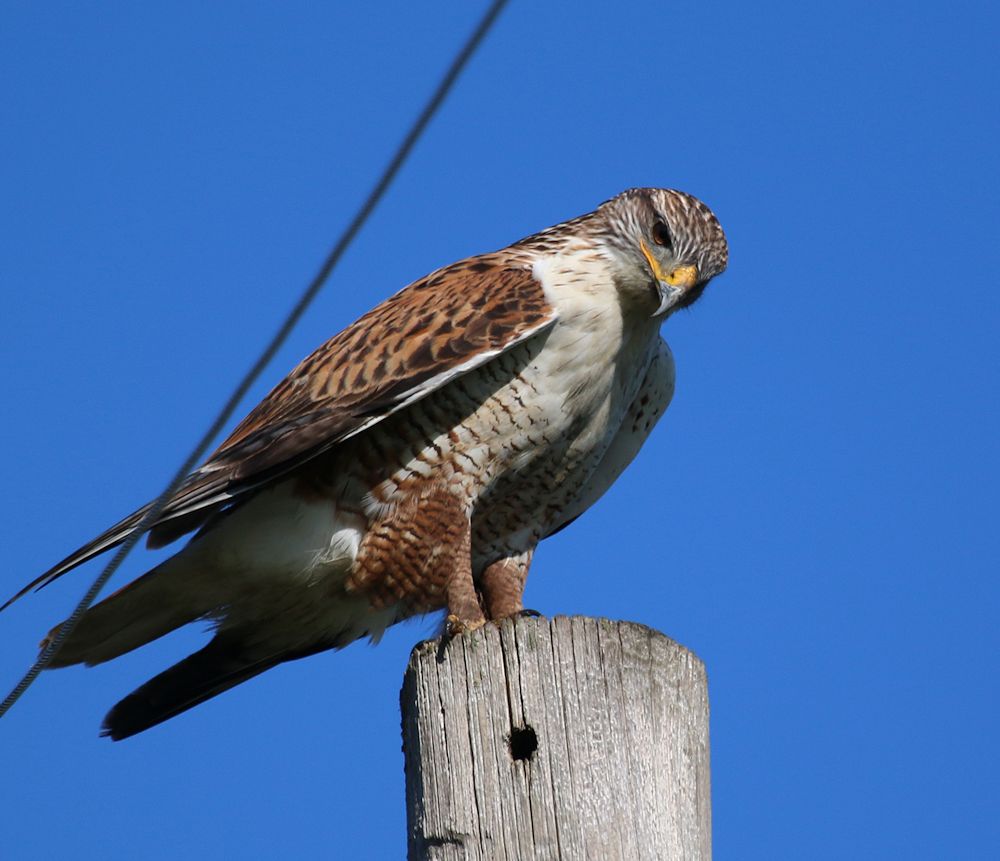 All Ferruginous Hawk photos by Dave Harper
All Ferruginous Hawk photos by Dave Harper
The Handsomest Hawk You’ve Never Heard Of
By Allen Fish
Let’s be honest, you’ve never heard of the Ferruginous Hawk because of that clunky name. It’s hard to remember and it’s harder to say. One 1850s term for this bird, the Rusty-chapped Squirrel-Hawk, was far superior, both in fact and in its unapologetic, western bravado. I prefer the MiIky-White Buzzard, for its sheer descriptiveness, but no one asked me. The Gopher Hawk and the Prairie Eagle do it justice as well. “Ferruginous” (pronounced “fuh – rue’ – jen – us”) is a mouthful of marbles that translates to “rust-colored” (like the word “ferrous”) which is the color of the highlights of the adult hawk only. The young hawk, in its first-year of life, is mostly milky-white (like the adult) with highlights in browns and grays.
What exactly is a Ferruginous Hawk? Well, take in your hands an adult Red-tailed Hawk. Imagine it is made of clay and you can re-shape it. First, add about one-third more clay and beef up the body, especially the chest. Add some heft to the head as well, then flatten the crown a bit so the new head shape is akin to a small Golden Eagle. Use your pointer fingers to pull the corners of the mouth back, just under the eye on each side. The resulting gape has to be large enough to take down a good portion of a Prairie Dog or a Belding Ground Squirrel. Then build up the upper leg muscles, and where the Redtail shows scales on the lower legs, add rust-colored feathers all the way down to the tops of the feet. Voila: rusty chaps!
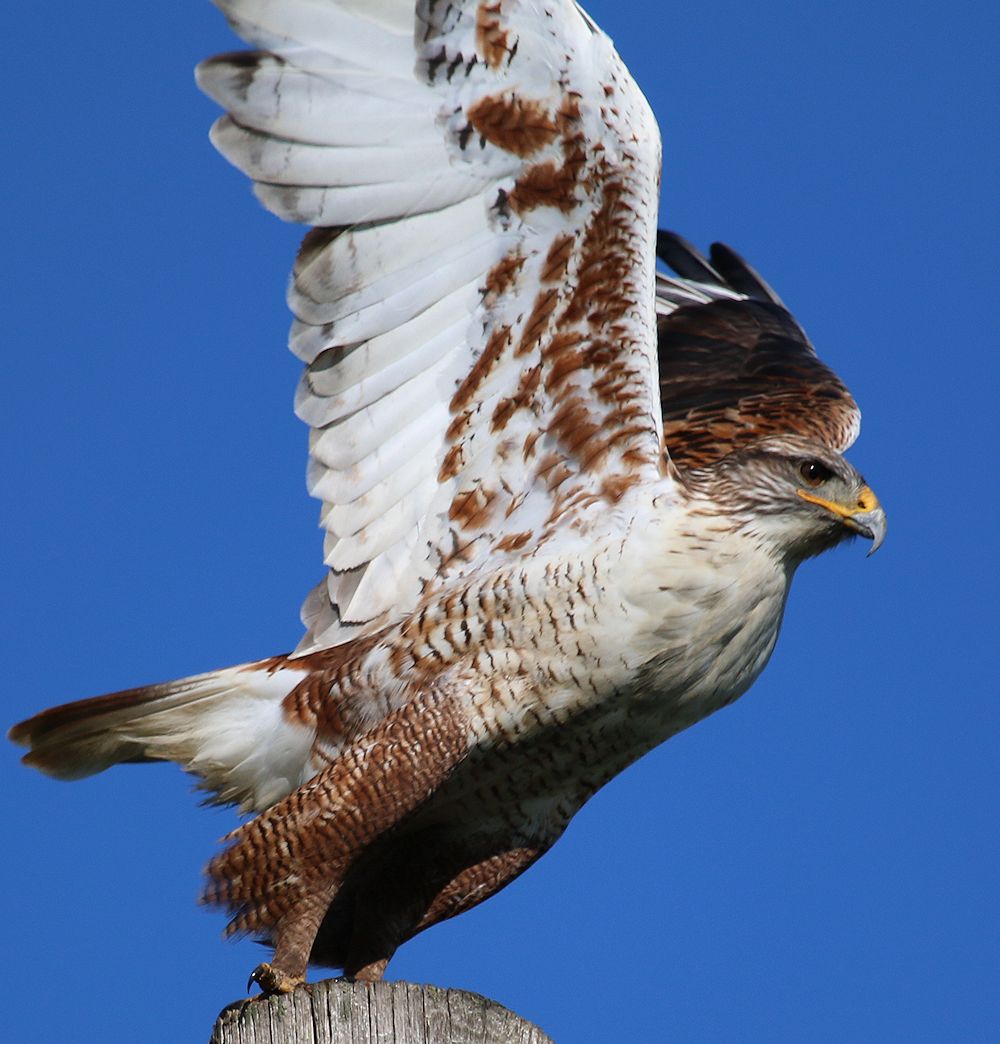 Although there is much overlap in Red-tailed Hawk and Ferruginous size partly due to the great size difference in hawks between the bigger females and the smaller males, in California, the largest Redtails are about the same size as the average-sized Ferruginous Hawk. A large Ferruginous has a wingspan right about five feet long; a large Redtail would be about four inches shorter. A large Ferruginous would weigh in at four and a half pounds; a large Redtail, about three and a half pounds.
Although there is much overlap in Red-tailed Hawk and Ferruginous size partly due to the great size difference in hawks between the bigger females and the smaller males, in California, the largest Redtails are about the same size as the average-sized Ferruginous Hawk. A large Ferruginous has a wingspan right about five feet long; a large Redtail would be about four inches shorter. A large Ferruginous would weigh in at four and a half pounds; a large Redtail, about three and a half pounds.
If this hawk is so darned big, why haven’t you seen one yet? Perhaps because you haven’t been lying on your back in a remote prairie with a ground squirrel tied to your chest? Ferrugs may be big-boned, but they are very selective about where they live and what they eat. Habitat-wise, Ferruginous Hawks enjoy wide, open grasslands and a bit of wind—prairies or savannahs of the western half of the US. Prey-wise they have five primary preferences: Prairie Dogs, Ground Squirrels, Pocket Gophers, Jackrabbits, and everything else. Notice that four of those things are meaty, medium-sized colonial mammals, while the fifth is: all other small creatures you might find in a grassland habitat: mice, magpies, meadowlarks, snakes, skinks, lizards, and large crickets and grasshoppers. And of course rats.
RAPTORS ARE THE SOLUTION celebrates the rat-catchers among our land and sky-predators; we exist to show off the magnificent, native predators that help us keep rat numbers down. But these are not urban raptors. When are these human-skittish, open-space-loving “Gopher” Hawks likely to run across a large population of rats, much less rat poison? A decade ago, it was generally assumed that second-generation, anticoagulant rat poisons were mostly the problem of cities and suburbs—places where rats ran amok, where farm cats and free-ranging rat terriers couldn’t do the job. But we now know that is not true.
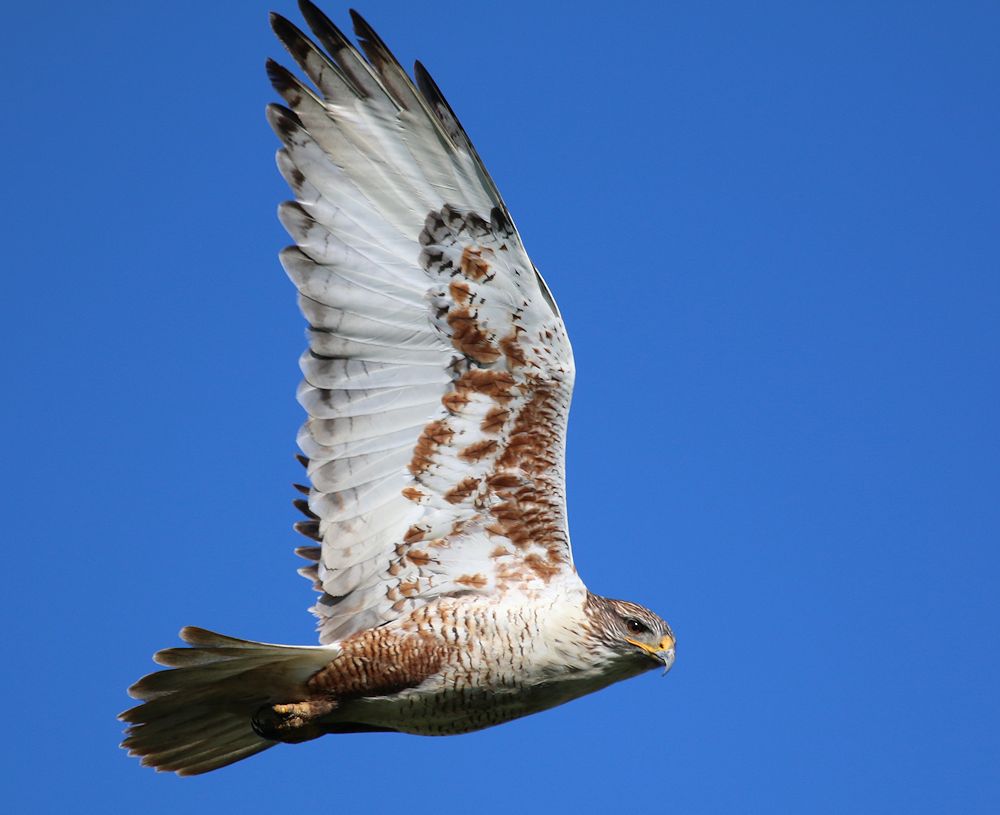 Where I live in California, rat poisons have been used to attempt to reduce ground squirrel populations from the leveed waterways of the Delta region and of San Francisco Bay. Both regions are havens for wintering Ferruginous Hawks. Rat poisons are regularly used in housing developments in the outer edges of the greater Bay Area, such as in Contra Costa and Santa Clara counties. As we build neighborhoods into these former ranchlands, we rarely see the prey and predators that have been active in these areas for thousands of years. When the resident rats or ground squirrels or gophers discover our gardens, we buy rat poisons to defend our spaces, but inadvertently we wipe out the local predators as well—Great Horned Owls, Kit Foxes, Bobcats, Red-tailed Hawks, and even Ferruginous Hawks.
Where I live in California, rat poisons have been used to attempt to reduce ground squirrel populations from the leveed waterways of the Delta region and of San Francisco Bay. Both regions are havens for wintering Ferruginous Hawks. Rat poisons are regularly used in housing developments in the outer edges of the greater Bay Area, such as in Contra Costa and Santa Clara counties. As we build neighborhoods into these former ranchlands, we rarely see the prey and predators that have been active in these areas for thousands of years. When the resident rats or ground squirrels or gophers discover our gardens, we buy rat poisons to defend our spaces, but inadvertently we wipe out the local predators as well—Great Horned Owls, Kit Foxes, Bobcats, Red-tailed Hawks, and even Ferruginous Hawks.
A Brief Introduction to the Tiger with Wings
By Maggie Rufo
Let’s start with a few questions:
Q: What does a Great Horned Owl eat?
A: Whatever it wants.
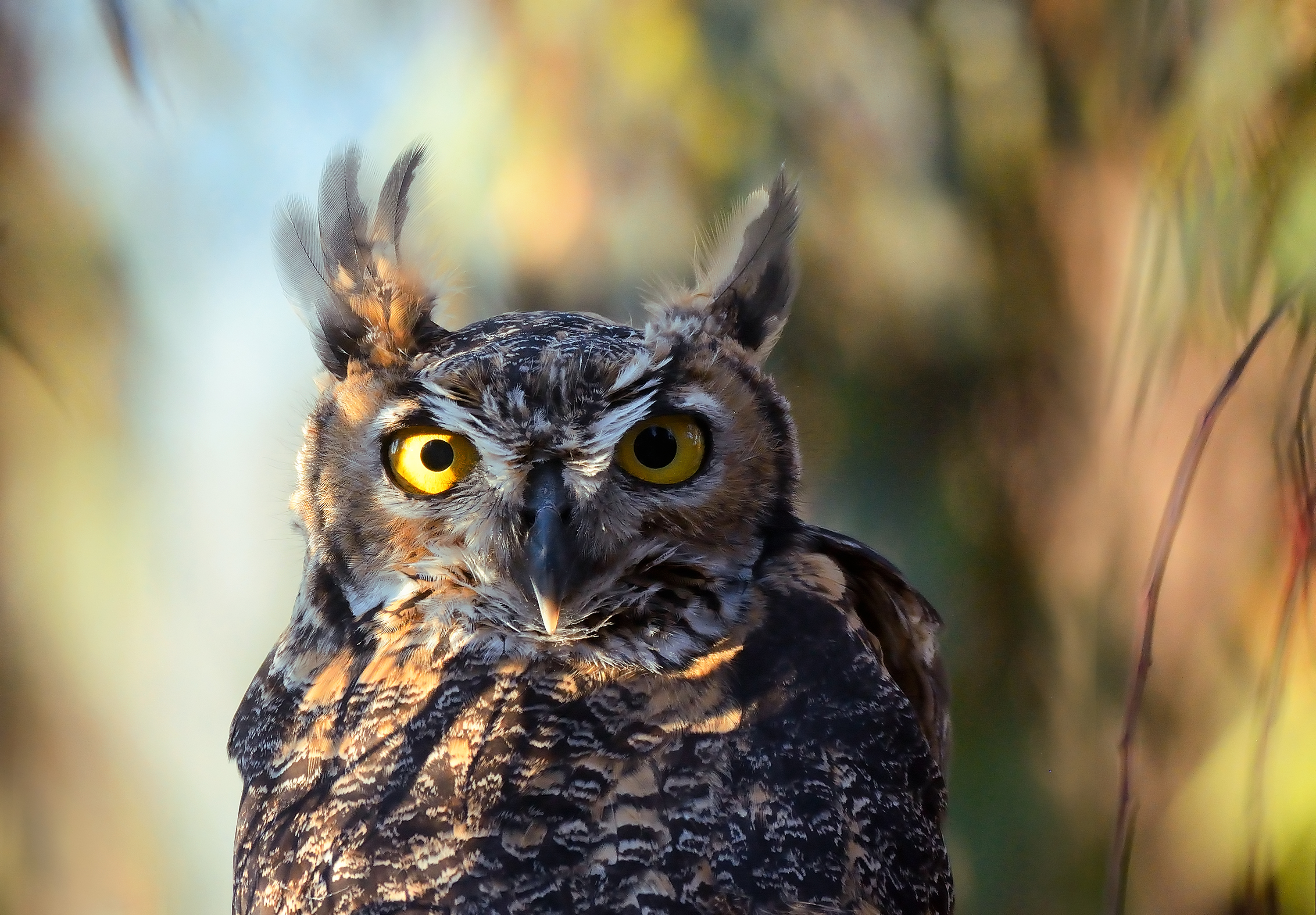 Great Horned Owl by Jerry Ting
Great Horned Owl by Jerry Ting
This owl eats the most diverse diet of just about any animal. They will take prey larger than themselves, including other raptors, and skunks (comes in handy to have little-to-no sense of smell). But they will also eat smaller items such as rodents, insects, bats, or fish. Yes, sometimes they have taken small cats or dogs. It’s generally not safe for pets to be alone outdoors after dark, in part because of these tigers with wings!
Great Horned Owls are considered crepuscular, which means they are most active at dawn and dusk. They perch on snags at the edges of forests, and their silhouette is easily recognizable with the large “ear” tufts. But their ears are actually on the sides of their head and are placed asymmetrically—this allows the silent winged tiger to hear its prey moving around below.
Q: Where does a Great Horned Owl nest?
A: Wherever it wants.
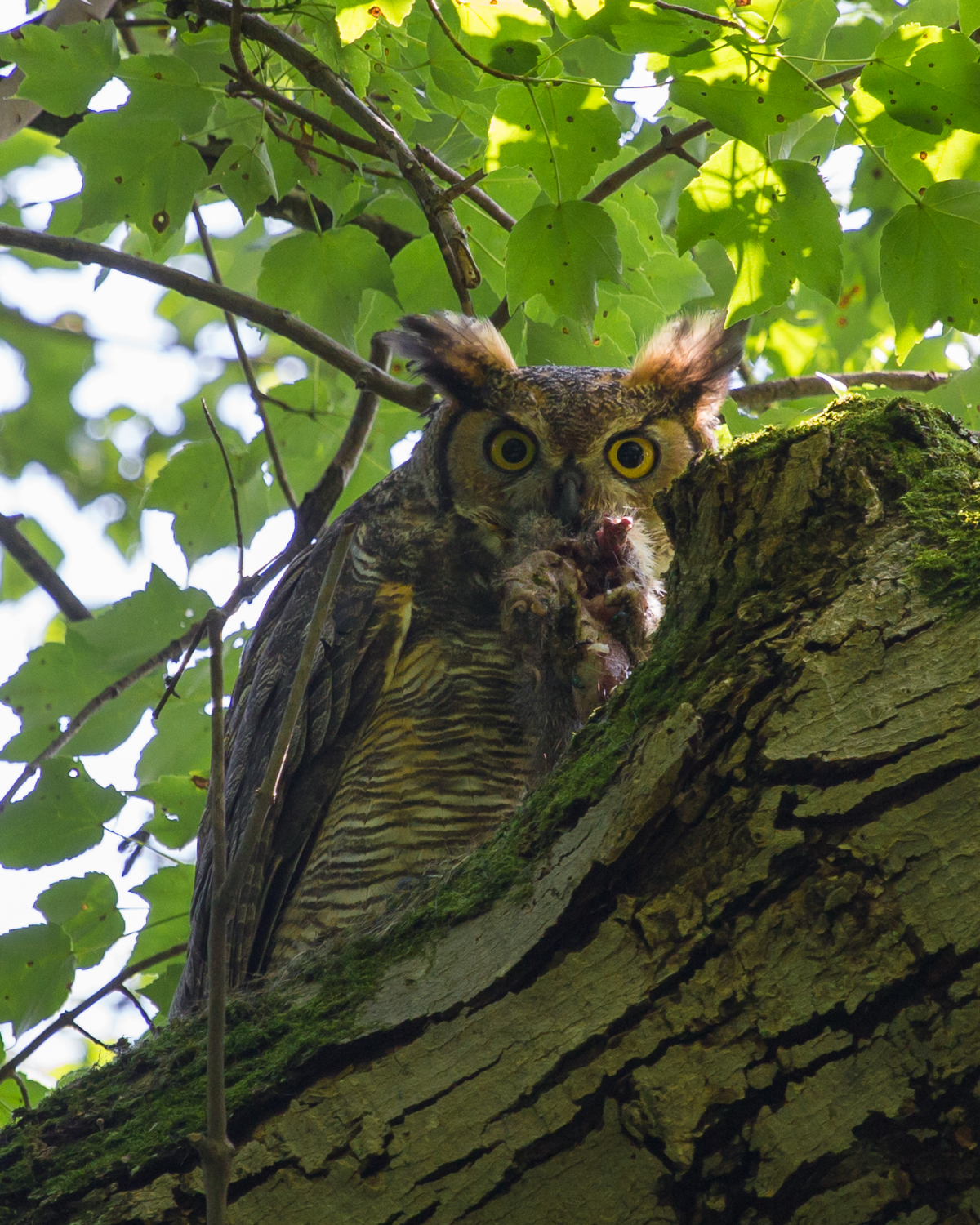 Great horned with prey by Pamela Dimeler
Great horned with prey by Pamela Dimeler
Like most owl species, the Great Horned doesn’t build a nest. By being the earliest nester in North America, the Great Horned has its pick of the unused nests of hawks and other large birds. Even if no nests are available they will use platforms, scrapes on the ground, and human-made structures. In regions where it snows, the Great Horned can be seen sitting on a snow-covered nest. This owl has feathers all the way down its legs and covering its toes. The female is larger than the male (this is true of most raptors species). There is no accepted reason why females are larger, but there are hypotheses. One is that the female does the incubating and feeding of the young during their first few weeks when they are helpless and cannot keep themselves warm. During this time the male brings food to the nest for her to give the young. Her large size keeps the chicks warm and also fends off predators. The second possible reason is that once her chicks are old enough for her to leave the nest for more than a few minutes, she too can hunt and, by being larger, can bring in different prey than her mate.
Q: What do they sound like?
A: Have you ever watched a scary movie in which they showed a big owl in a tree hooting away? That’s the sound of a Great Horned Owl. They have a series of hoots in a specific pattern. The male’s voice is deeper than the female. Listen here.
Q: What does a Great Horned Owl fear?
A: Not you!
The Great Horned Owl (Bubo virginianus) is an apex predator—after dark. This owl, weighing in at up to four pounds, fears no other creature. In fact, a healthy, adult Great Horned Owl really has no natural predators except perhaps when in a territorial dispute with another healthy, adult Great Horned Owl or a large raptor like the Goshawk. Great Horneds are extremely protective of their territory, and will attack anyone who tries to come near their nest—including humans. Mortality, outside of natural causes, comes from human sources: car strikes, deliberate shooting, tree cutting, and the use of rodent poisons. No matter its amazing powers, the night’s top hunter can be brought down by secondary rodenticide poisoning, just like any other beneficial predator.
 Great Horned with prey by Pamela Dimeler
Great Horned with prey by Pamela Dimeler
It’s hard not to wax poetic about this owl. Borrowing a few lines from William Blake for our winged tiger:
Tyger Tyger, burning bright,
In the forests of the night;
What immortal hand or eye,
Could frame thy fearful symmetry?
When a Great Horned Owl turns those fierce yellow eyes in your direction, you know you have been seen!
